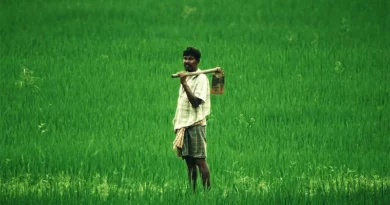Monsoon rainfall increased in 55% of Indian tehsils in last 10 years amid climate change: CEEW
05 February 2024, New Delhi: Majority of India is seeing a surge in southwest monsoon rainfall, with 55 per cent of ‘tehsils’ or sub-districts seeing a significant increase of more than 10 per cent in the last decade (2012-2022), according to a new independent study by the Council on Energy, Environment and Water (CEEW) released today. This includes tehsils in traditionally drier regions such as Rajasthan, Gujarat, central Maharashtra, and parts of Tamil Nadu. Out of these, nearly a quarter of the tehsils are seeing a pronounced rainfall rise of over 30 per cent during the June to September period. The CEEW study, Decoding India’s Changing Monsoon Patterns—which is a first-of-its-kind granular analysis of rainfall in more than 4,500 tehsils across India spanning 40 years (1982-2022)—finds fastshifting and erratic monsoon patterns in the last decade. This can be attributed to the accelerating rate of climate change.
Moreover, the CEEW study finds that the increased rainfall in these tehsils is frequently coming from short-duration, heavy rainfall, which often leads to flash floods. For instance, 31 per cent of Indian tehsils experienced an increase of four or more days of heavy rainfall per year in the last decade (in comparison to the previous 30 years) during the southwest monsoons. As 2023 was declared the hottest year on record globally, and 2024 is expected to continue that trend, the impacts of the climate crisis will be seen in the form of increased extreme weather events. For instance, in 2023, Chandigarh received nearly half of its total annual rainfall in just 50 hours, while Kerala encountered a near 60 per cent deficit in June (IMD 2023).
The monsoons are crucial for the Indian economy and are often regarded as the backbone of the agricultural sector, which employs over half of India’s population. However, the CEEW study finds that while only 11 per cent of Indian tehsils saw a decrease in southwest monsoon rainfall in the last decade, but they are located in the rain-fed Indo-Gangetic plain, northeast India and the upper Himalayan region. These areas are crucial for India’s agricultural output and contain fragile ecosystems particularly vulnerable to extreme climate events.
Dr Vishwas Chitale, Senior Programme Lead, CEEW, said, “As India readies for the 2024 Union Budget, it will be crucial to focus on future-proofing the economy against increasingly erratic rainfall patterns. The monsoons impact the food we eat, the water we drink and also our energy transition. CEEW’s study not only maps monsoon variability—both southwest and northeast—over the past 40 years across India, but also provides openly-accessible tehsil-level rainfall information for decision-makers to assess risks at the local level. With increasing extreme weather events, hyper-local climate risk assessments and action plans are the way to go for India to keep leading in climate action and disaster risk reduction. This will help save lives, livelihoods and infrastructure.” Further, the CEEW study finds that the increase in rainfall is not well distributed throughout the seasonsand months. Out of the total tehsils that saw a decrease in southwest monsoon, 87 per cent of them, located in states such as Bihar, Uttarakhand, Assam, and Meghalaya, saw a decline in rainfall during the initial monsoon months of June and July, which are crucial for sowing kharif crops. On the other hand, 48 per cent of tehsils in India saw an increase in October rainfall by more than 10 per cent, which could be due to the delayed withdrawal of the southwest monsoon from the subcontinent. This has direct implications for the sowing of rabi crops during this time

The study also shows changing patterns in the northeast monsoon—from October to December— which is particularly crucial for peninsular India. The northeast monsoon rainfall has increased by more than 10 per cent in the last decade in approximately 80 per cent of tehsils in Tamil Nadu, 44 per cent in Telangana, and 39 per cent in Andhra Pradesh. Further, Odisha and West Bengal on the East coast and Maharashtra and Goa on the West coast are seeing an increase in rainfall during this period.
Shravan Prabhu, Research Analyst, CEEW, said, “The occurrence of extreme weather events in India such as droughts and floods is closely linked to Indian monsoons. Our research reveals that the Indian monsoons, which inherently show high variability, are seeing even more intense changes over the last decade, showcasing a swapping pattern. To effectively address these emerging challenges, the impacts of monsoon variability on key sectors such as agriculture, water, and energy should be mapped and integrated into climate action plans at all levels — from states to districts.”
Finally, while India experienced 29 ‘normal’ southwest monsoons in the last 40 years, the CEEW study demonstrates the need to analyse it at a more granular district or tehsil level. Using the finest resolution data from the National Monsoon Mission by the Ministry of Earth Sciences, the study finds that approximately 30 per cent of India’s districts witnessed a high number of deficient rainfall years and 38 per cent witnessed a high number of excessive rainfall years over the last 40 years. Of this, 23 per cent of districts such as New Delhi, Bengaluru, Nilgiris, Jaipur, Kachchh, and Indore, witnessed both a high number of deficient as well as excessive rainfall years. Therefore, the development of districtlevel climate action plans incorporating tehsil-level climate risk assessments is crucial to implement adaptation strategies at the sub-national level.
Also Read: Rallis India scales up supply chain effectiveness through digital platform ‘Plan Guru’
(For Latest Agriculture News & Updates, follow Krishak Jagat on Google News)















